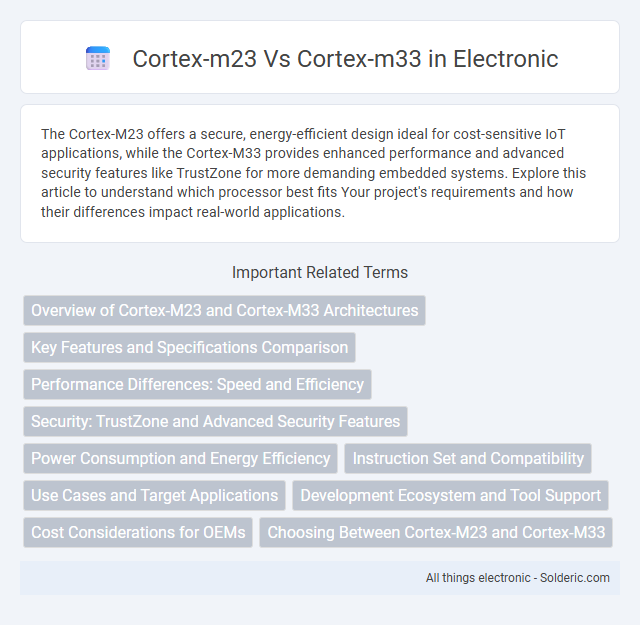The Cortex-M23 offers a secure, energy-efficient design ideal for cost-sensitive IoT applications, while the Cortex-M33 provides enhanced performance and advanced security features like TrustZone for more demanding embedded systems. Explore this article to understand which processor best fits Your project's requirements and how their differences impact real-world applications.
Comparison Table
| Feature | Cortex-M23 | Cortex-M33 |
|---|---|---|
| Architecture | Armv8-M Baseline | Armv8-M Mainline |
| Performance | Up to 0.98 DMIPS/MHz | Up to 1.25 DMIPS/MHz |
| Bit-width | 32-bit | 32-bit |
| TrustZone Security | Supported | Supported |
| FPU (Floating Point Unit) | Not available | Optional single-precision FPU |
| DSP Instructions | Limited | Enhanced DSP instructions |
| Interrupts | Low IRQ count | Higher IRQ count with NVIC |
| Power Efficiency | Highly optimized for low power | Balanced power and performance |
| Use Case | IoT edge devices, low-cost secure MCUs | Advanced embedded systems, wireless devices |
Overview of Cortex-M23 and Cortex-M33 Architectures
The Cortex-M23 is a low-power, secure microcontroller core designed with ARM's TrustZone technology, optimized for cost-sensitive IoT and embedded devices. The Cortex-M33 builds on the M23 architecture, adding enhanced DSP instructions, higher performance, and more advanced security features, making it suitable for complex applications requiring real-time processing capabilities. Your choice between these cores depends on the balance you need between power efficiency and computational power.
Key Features and Specifications Comparison
The ARM Cortex-M23 is designed for low-power, cost-sensitive applications and supports the Armv8-M architecture with TrustZone security, featuring a 2-stage pipeline and optional Floating Point Unit (FPU). In contrast, the Cortex-M33 offers enhanced performance with a 3-stage pipeline, higher clock speeds, DSP instructions, and an integrated FPU, making it suitable for more demanding embedded applications. Your choice between Cortex-M23 and Cortex-M33 should consider the balance between power efficiency and processing capability based on system requirements.
Performance Differences: Speed and Efficiency
The Cortex-M33 delivers higher performance than the Cortex-M23, featuring a more advanced DSP and optional floating-point unit, which boosts speed and computational efficiency for complex tasks. Its enhanced pipeline design and larger TCM support lead to faster execution and lower latency in real-time applications. You can expect the Cortex-M33 to provide better performance in speed-intensive and efficiency-sensitive projects compared to the Cortex-M23.
Security: TrustZone and Advanced Security Features
Cortex-M33 offers enhanced security features compared to Cortex-M23 by supporting ARM TrustZone technology, enabling secure and non-secure world separation for sensitive data and code execution. Cortex-M33 includes advanced security extensions such as cryptographic accelerators and secure debug, providing robust protection for IoT and embedded applications. Your choice of Cortex-M33 equips your system with comprehensive hardware-enforced security, while Cortex-M23 provides a more basic TrustZone implementation suitable for lower-complexity devices.
Power Consumption and Energy Efficiency
The Cortex-M23 delivers ultra-low power consumption optimized for energy-efficient applications, making it ideal for battery-powered and IoT devices requiring minimal energy usage. In contrast, the Cortex-M33 offers higher performance with enhanced power management features, balancing energy efficiency with increased processing capabilities. Your choice depends on the trade-off between maximum energy savings with the Cortex-M23 and the more robust performance-per-watt efficiency of the Cortex-M33.
Instruction Set and Compatibility
The Cortex-M23 supports the ARMv8-M Baseline architecture with TrustZone security extensions, offering a smaller instruction set optimized for low-power applications. The Cortex-M33, based on the ARMv8-M Mainline architecture, includes a richer ARMv8-M instruction set and provides enhanced DSP and floating-point capabilities while maintaining backward compatibility with Cortex-M23 instructions. Both cores support the Thumb-2 instruction set, but the Cortex-M33 delivers greater performance and security features due to its extended instruction set and architecture.
Use Cases and Target Applications
The Cortex-M23 is optimized for ultra-low-power and security-sensitive IoT applications such as wearable devices and smart sensors, where energy efficiency and TrustZone security are critical. The Cortex-M33 offers higher performance and enhanced DSP capabilities, making it suitable for more complex applications like motor control, embedded AI, and advanced industrial automation. Your choice hinges on balancing power efficiency with processing power and security needs in your target application.
Development Ecosystem and Tool Support
The Cortex-M33 benefits from broader development ecosystem support with enhanced integration of TrustZone security features, enabling advanced secure application development compared to the Cortex-M23. Both cores are supported by major IDEs like Keil MDK and IAR Embedded Workbench, but Cortex-M33 offers optimized tools for DSP and Floating Point Unit (FPU) development, providing more robust debugging and performance profiling options. Extensive middleware, RTOS support, and Arm's Developer Studio compatibility are more mature for Cortex-M33, facilitating complex IoT and embedded security projects.
Cost Considerations for OEMs
The Cortex-M23 offers a cost-effective solution for OEMs prioritizing budget with its streamlined design and lower silicon area, making it ideal for simple IoT devices and entry-level applications. In contrast, the Cortex-M33 provides enhanced security features and higher performance at a slightly increased cost, suitable for more complex embedded systems requiring robust processing capabilities. Your choice between the two should balance the need for advanced features against the overall project cost constraints.
Choosing Between Cortex-M23 and Cortex-M33
Cortex-M23 offers a compact, energy-efficient solution optimized for cost-sensitive IoT applications with TrustZone security features, ideal for battery-powered devices requiring basic security. Cortex-M33 provides higher performance with enhanced DSP capabilities, larger memory support, and advanced security, suitable for complex embedded systems demanding real-time processing and robust cybersecurity. Choosing between them hinges on balancing power efficiency and security needs against processing power and system complexity.
cortex-m23 vs cortex-m33 Infographic

 solderic.com
solderic.com